Five species of deer reside in Thailand, though only three are likely to be encountered since the other two are very rare. Thailand also has three species of “mouse-deer” (aka chevrotain), but despite this name, mouse deer are not actually deer, and they do not have antlers.
Two common features of all five deer species are their facial scent glands and white fur on the undersides of their tales. The preorbital glands sit right next to the deer’s eyes and are thus clearly visible, unlike their other scent glands located elsewhere, such as the legs. They rub these glands on trees, the ground, or other suitable things to mark territory. They also use urine for this.
Deer raise their tails when fleeing from perceived predators. Recent research with white-tailed deer casts serious doubt on the widespread idea that this bright tail flash serves as a signal to other deer. Rather it appears that it may somehow pause (perhaps by confusing) a predator, giving the deer at least a few extra moments to escape. And deer often drop their tales while still running, which may cause the predator to lose track of them.
Males of all five of these deer species also fight to both defend territory and retain mates by locking antlers and pushing in a test of strength until the weaker deer surrenders. This usually does not result in any injury. The antlers are shed annually.
Sambar Deer
Thai Name: กวาง
Scientific Name: Rusa unicolor
Other Names: Indian Sambar Deer, กวางป่า, กวางม้า, กวางแซมบาร์
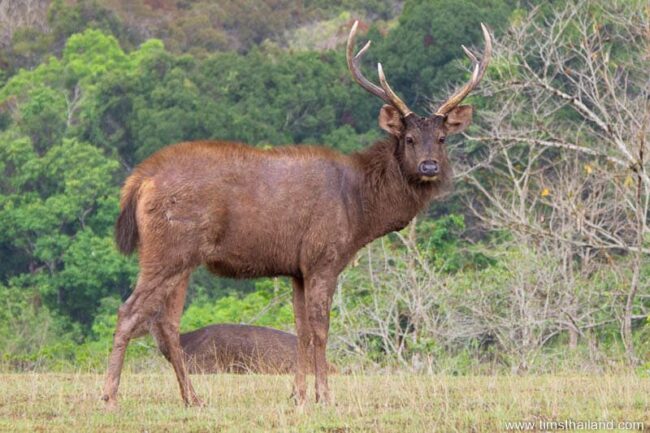
Physical Description
Average adult weight: 180kg
Shoulder height: 140cm
Head and body length: 2m
The world’s third largest deer species (after moose and elk) can max out well over 500kg, though this size is uncommon. Unlike the other deer in Thailand, sambar have shaggy fur, and in males, it’s noticeably longer around its neck.
At age one or two, sambar antlers have a single point (aka tine). In their third year, the antlers have two points, and then fully mature adults have three or even four points, and the antlers typically reach over a meter in length.
Something unique in the animal world, male sambar deer and lactating females have a large oozing gland in the center of their throats known as a “sore spot.” While it looks like a wound, and at times it is actually bloody, it’s natural and not unhealthy. The purpose is unknown, though because it is most pronounced during the rut, it could be related to pheromones.
Habitat
Sambar deer inhabit a wider variety of forest types than most ungulates. They prefer being near open areas, such as grasslands, farm fields, and roads, and rarely go far away from water sources. Because they prefer open areas, sambar deer are more commonly seen in degraded forest than in pristine. Some sambar deer move between higher elevations in the hot season and lower elevations in the cool season.
Behavior
Sambar deer are mostly nocturnal and crepuscular (active at dawn and dusk), spending the daytime resting in heavy forest cover. Though in the absence of hunting, they may be active in the daytime too. When sensing danger, sambar deer may stamp their feet and scream a high-pitched alarm call before fleeing. They are also excellent swimmers.
Sambar deer reproduce year-round, but breeding is most common from September through January. Though nomadic, males aggressively defend territory during their breeding season to mate with a group of up to eight females who remain in the male’s range. Outside of mating, sambar deer are mostly solitary, though females with dependent young sometimes stay together.
Conservation Status
The sambar deer’s IUCN Red List status is vulnerable due to habitat loss and hunting.
Indian Hog Deer
Thai Name: เนื้อทราย
Scientific Name: Axis porcinus
Other Names: Hog deer, ตามะแน
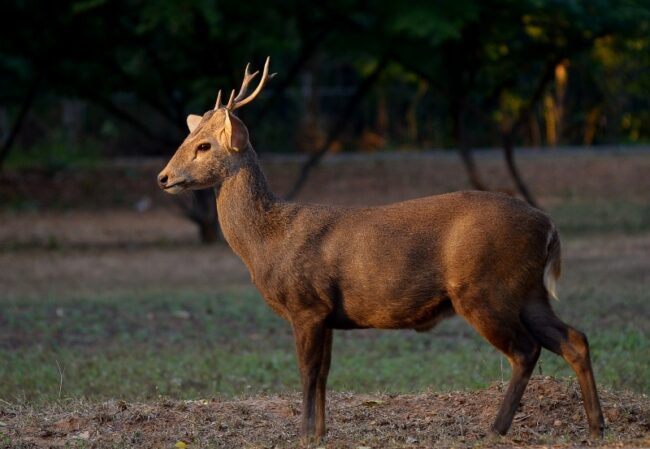
Physical Description
Average adult weight: 35kg
Shoulder height: 70cm
Head and body length: 1.25m
Short and stocky, hog deer are small but powerful. Their hind legs are longer than their fore legs, noticeably raising their rump higher than their shoulders. The antlers are typically three-pointed and around 35cm in length.
Habitat
Hog deer are found in both dense forest and wet and floodplain grasslands.
Behavior
Hog deer are solitary (except that they tolerate each other in bountiful feeding areas), nocturnal (they rest in tall grass during the day), and territorial (they rarely move more than 400m in a day.) Hog deer do not gather a harem during the mating season (August to October); instead they fight over lone females. When they fear predators, hog deer make a warning bark and flee to dense cover. Aided by their relatively short legs, they run with their heads held low, ducking under branches rather than leaping over them like most deer do. This behavior, similar to wild boars, is apparently the source of their name. Good swimmers, hog deer will also flee into water.
Conservation Status
The Indian hog deer’s IUCN Red List status is endangered due to habitat loss and hunting. It was nearly extinct in Thailand, holding on only in the northwest along the Burmese border, but has since been reintroduced to some Thai forests.
Barking Deer
Thai Name: เก้ง
Scientific Name: Muntiacus muntjac
Other Names: Indian muntjac, common muntjac, red muntjac, เก้งธรรมดา
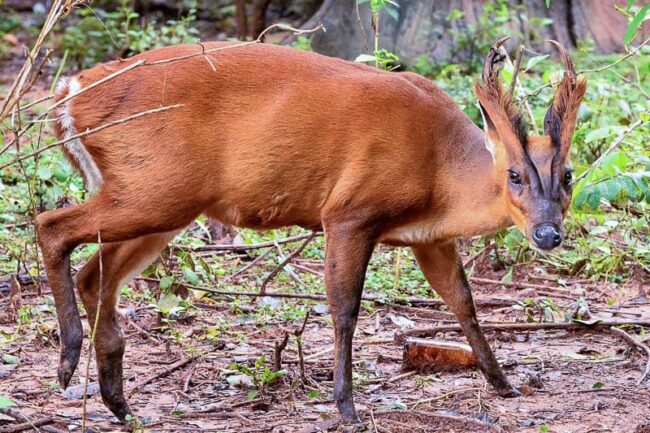
Physical Description
Average adult weight: 18kg
Shoulder height: 55cm
Head and body length: 1m
One of the smallest deer species, barking deer have distinctively dark faces with two black lines running down its forehead from the antlers to the nose. Their one-pointed antlers are only about 10cm long and extend out of hairy skull protrusions; females have these same protrusions, making it appear that they have antlers.
Most male muntjacs (of all species) have two inch-long curved canine teeth in the middle of their mouth that protrude like little tusks. Their tongue is very long (it can reach their eyes) and can be used to strip leaves off branches.
Habitat
Barking deer are seldom seen outside dense forests, probably because of the safety this habitat provides against predators, and they never venture far from water.
Behavior
Barking deer live solitary lives, and the males fiercely defend small territories. Though when they are in rut (barking deer have no specific breeding season), they will ignore these boundaries and roam around in search of mates, with males fighting amongst themselves to control a small harem of females. In addition to battling with their antlers, barking deer may attack with their canines, which can cause serious wounds. Barking deer are active both during the day and at night.
The barking deer’s name comes from its alarm call, which has some similarity to a dog’s bark. It is surmised that the call alerts a predator that it has been spotted and has lost the element of surprise. They may bark for over an hour: usually the better the visibility, the shorter the time.
Unlike most deer, barking deer are omnivores, and besides the expected diet of grass, sprouts, seeds, fruits, leaves, and bark, they also eat bird eggs, carrion, and small mammals. They hunt the latter by bashing them with their forehooves.
Conservation Status
The barking deer’s IUCN Red List status is least concern.
Fea’s Muntjac
Thai Name: เก้งหม้อ
Scientific Name: Muntiacus feae
Other Names: Tenasserim muntjac
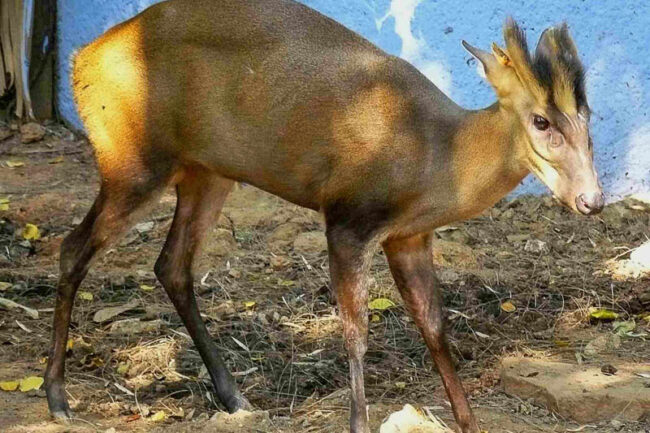
Physical Description
Average adult weight: 22kg
Shoulder height: 55cm
Head and body length: 1m
Fea’s muntjac is similar in appearance to barking deer, including the distinctive male canine teeth, with one significant difference: They do not have lighter undersides. One unusual feature is that female fea’s muntjacs are larger than males. (The other Thai deer species follow the normal larger male size.)
Habitat
Fea’s muntjac prefer moist tropical forests and rarely enter open areas.
Behavior
Little is known about the behavior of fea’s muntjac, but it is assumed to be similar in all regards to other muntjacs, including the barking deer.
Conservation Status
In 1996 the fea’s muntjac’s IUCN Red List status was changed from endangered to data deficient. Nothing, however, indicates that its situation has improved.
Fea’s muntjac live only along the Tenasserim Range along the border of Thailand and Myanmar, potentially from around Mae Sot (Tak province) in the north to Phang Nga province in the south. However, some of the sightings that established this territorial range are unreliable (they are often based on the sighted animal having a dark underside or a blackish tail, but this occasionally occurs in other muntjac species), and it could be much smaller. Some places they are known to inhabit are Kaeng Krachan National Park, Kuiburi National Park, and several units of the Western Forest Complex, including Mae Wong National Park and Thung Yai Wildlife Sanctuary. Because poaching is much more widespread on the Myanmar side of the border, it may have been wiped out in that country by now.
They were once also reported in Laos, Vietnam, and southern China, though not all biologists are convinced these were really fea’s.
Eld’s Deer
Thai Name: ละองละมั่ง
Scientific Name: Rucervus eldii
Other Names: Brow-antlered deer, Thamin Deer
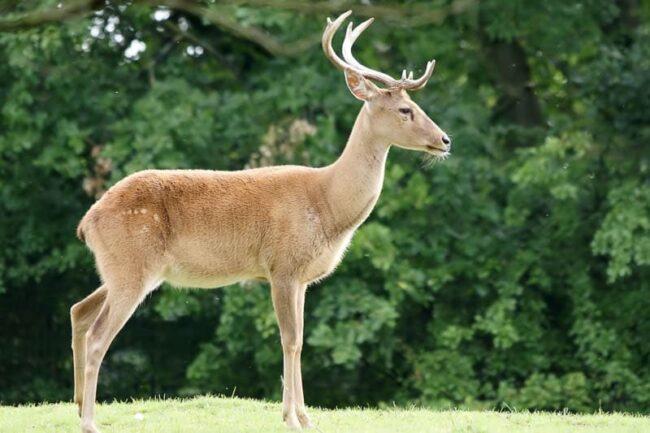
Physical Description
Average adult weight: 95kg
Shoulder height: 1.25cm
Head and body length: 1.65m
Eld’s are a relatively thin, long-legged, graceful-looking deer, about the same size as white-tailed deer. Their fur can get a little thick, but not as much as sambar deer. The antlers, which can reach a meter in length, have a unique continuous curved shape from front to back, and fully mature adults will have six, or possibly more, points per antler.
Habitat
The eld deer’s main habitat is deciduous dipterocarp forests, and they prefer being near open areas and water.
Behavior
While males are mostly solitary and territorial, females and their fawns often stay in herds. Although since their numbers have dropped dramatically, large herds are no longer common. During the breeding season, February to May, males join the herds and fight aggressively to control them. Eld’s deer are mostly nocturnal but also active at dawn and dusk. They prefer eating grass to leaves and are particularly keen on crops like rice, lentils, and corn.
Conservation Status
The eld deer’s IUCN Red List status is endangered due to habitat loss and hunting.
The eld deer’s historic range was from northern India across southern China and the north of Southeast Asia (above the Malay Peninsula), but now there are only highly fragmented populations in Myanmar, Cambodia (there are some in Preah Vihear province), Laos (there are some in Savannakhet province), Thailand, Hainan island, and far eastern India. It was previously extirpated from Thailand but has been reintroduced in a few places. Phu Khieo Wildlife Sanctuary had a reintroduction program that began in 1994, though none have been seen there for a very long time, and all are presumed dead. There are still some reintroduced eld’s deer at Maenam Phachi Wildlife Sanctuary (Ratchaburi) and Mae Ping National Park (Lamphun): they are not very timid in the latter and sometimes walk through the campground at night. The native subspecies, R. e. siamensis, is the most endangered of the three (probably under 200 remain both wild and captive), and the reintroductions were of the Burmese subspecies, R. e. thamin.
Hog deer photo by วิชิต กองคำ from Wikimedia Commons.
Barking deer photo by Kongkham6211 from Wikimedia Commons.
Fea’s muntjac photo by Mammalwatcher from Wikimedia Commons.
Eld’s deer photo by Hans Hillewaert from Wikimedia Commons.